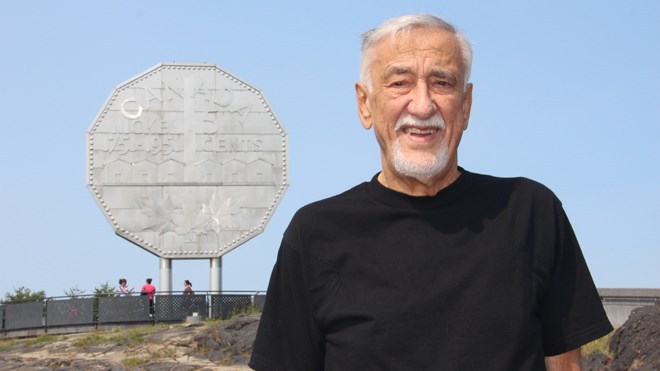Editor’s note: On March 1, Northern Life/Sudbury.com presented the 15th annual Community Builders Awards of Excellence, celebrating those Sudburians who make or have made a significant impact on our community. Over the next few days, we will introduce you to all the winners.
Sudbury’s famous Big Nickel almost wasn’t built.
In the early 1960s Ted Szilva purchased land in the city’s West End from the Holditch family with plans to build the attraction. But “the city said they would never allow me to build up there, and they wouldn’t give me a building permit,” he told CBC Radio in 2014.
“They thought it would be a Mickey Mouse operation. Look at what happened to Mickey Mouse!”
Inco Ltd. stepped in to help. “[They said] we’ll lease you the additional land of four acres just so you can build the road up — and also built the (stainless steel) nickel,” Szilva said.
The Big Nickel received its first visitors on July 22, 1964, and it has since attracted countless tourists from around the world.
Theodore Arthur “Ted” Szilva died in March 2016 at the age of 81. He lived long enough to celebrate the silver anniversary of Sudbury’s Big Nickel, which is considered one of the top roadside attractions in Canada.
Szilva was a visionary who played a leading role in developing the idea of the landmark at a time when few people thought the region’s mining heritage would be of interest to tourists.
Szilva, then a 27-year-old firefighter, presented an idea for a giant coin tourist attraction to Sudbury’s Canada Centennial Committee, which was looking for ideas to celebrate the country’s 100th birthday.
“The nickel was to show where our wealth came from, the rock, and a lasting tribute to the men and women who processed minerals in the Sudbury Basin,” Szilva wrote in a 1996 newspaper column.
The committee was not inspired, so Szilva decided to pursue his idea for the Canadian Centennial Numismatic Park on his own.
Originally, the park featured giant replicas of Canadian and American pennies, a $20 gold coin, and an American Kennedy half dollar as well as the 1951 Canadian nickel with King George VI on the “heads” side and Sudbury’s nickel refinery on the “tails” side. The 1951 coin was issued to celebrate the 200th anniversary of the naming of the element nickel by the Swedish chemist A. F. Cronstedt in 1751.
Visitors could ride a carousel and a small train. MacIsaac Mining and Tunnelling Company built a tunnel at the site that became the Big Nickel Mine in 1965.
In the early 1980s, Szilva sold his property to the municipality when city leaders realized the tourist potential of building an attraction to highlight the area’s unique geology and mining riches.
Upgrades made to the Big Nickel Mine were finished in 1983 in time to celebrate the City of Sudbury’s 100th anniversary. The summer Science North opened in 1984, attendance at the Big Nickel Mine increased by 30 percent over the year before.
Fast forward to 1997. That year plans were developed to update the Big Nickel Mine experience into the city’s second major tourist attraction, Dynamic Earth.
Szilva was a Community Builder who was president of Nickel Printing (of which he owned a 30-per-cent stake; the business was founded by Lorne Maisonneuve and his son, Rick) and owned several companies. In the late 1980s, Szilva purchased the old Empire Theatre, a former opera house built in 1909 and converted it into the 1,200-seat Grand Theatre Centre, which for a time attracted top entertainment to the city.
The proud Sudburian was a dedicated member of his church, a founding member of the Bishop Alexander Carter Charitable Fund, and its treasurer from 1981 to 2001. During that time, the fund distributed more than $20 million to more than 200 charities.
A man of service, Szilva was a director of the Sudbury District Chamber of Commerce and the Rainbow District Tourist Association. He served on the boards of Sudbury General Hospital, Childhood/L’Enfance, and the Catholic Family Enrichment Centre.
He was the founding president of The Blue Door Soup Kitchen. He was padre of the International Professional Firefighters Association, Local 527 Sudbury, chaplain of the City of Greater Sudbury Fire Services, and padre of the War Pensioners of Canada, Fred Vincent Branch.
In 1988 Szilva was awarded the Diocesan Gold Medal of Merit for outstanding contributions to the life of the Catholic Church in the Diocese of Sault Ste. Marie. He was awarded the Order of Ontario in 2009 and an honorary doctorate from Laurentian University in 2010.
In 2014, Szilva and his son, Jim, published The Big Nickel, The Untold Story.
Szilva’s wife, Betty, shares these thoughts. “We know Ted was driven to bring to the people of Sudbury, and to the world, a unique monument that would celebrate Sudbury as the Nickel Capital of the World – grow the tourist industry and benefit the region economically – and be a source of pride. He did that with the support of many good and wise people in this community.
“The success of the project prepared him for all that came after it. There was no job that was beneath Ted, and no task he would not take on if he knew someone was in real need. His life became a life of service, to his family, his church and his community.”
For 15 years, the Community Builders Awards have recognized individual Sudburians and groups whose works and efforts have made our community the “greater” place it is. To learn about past winners, this year’s winners and to find out how to nominate someone you know for a Community Builders Award, visit our website, CBAwards.ca.
